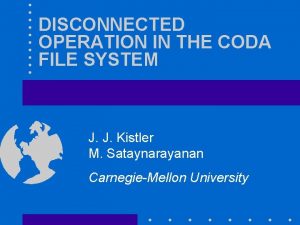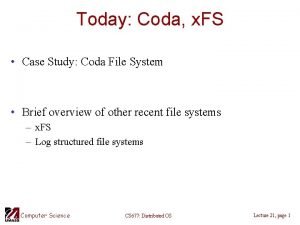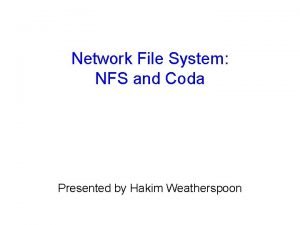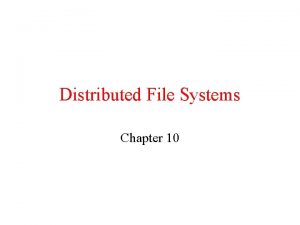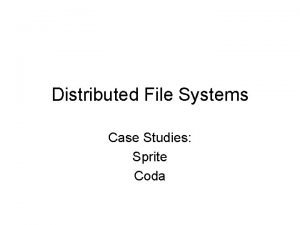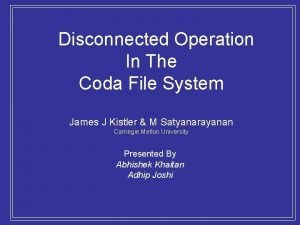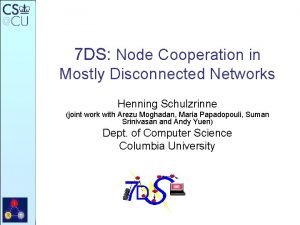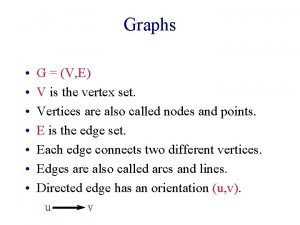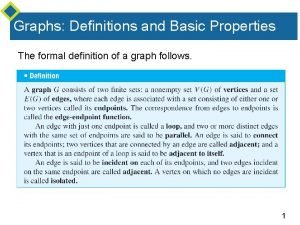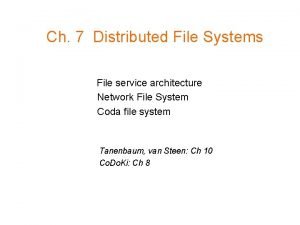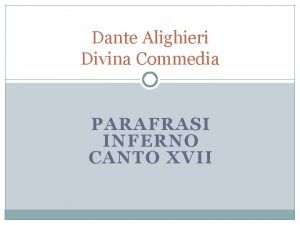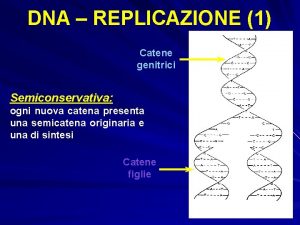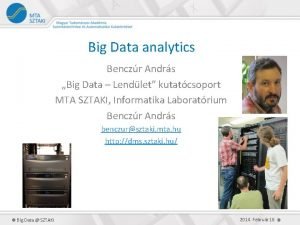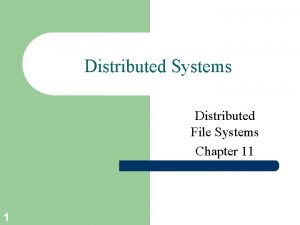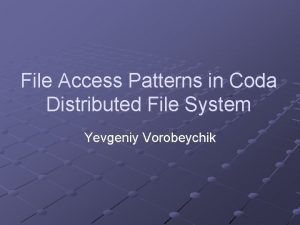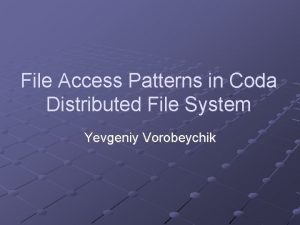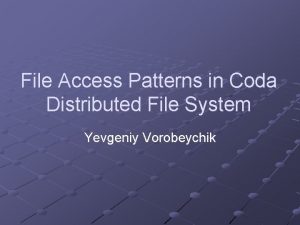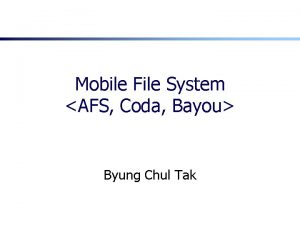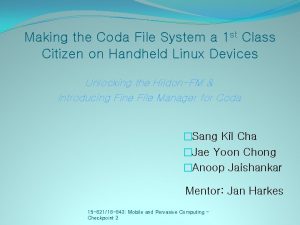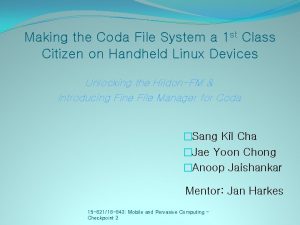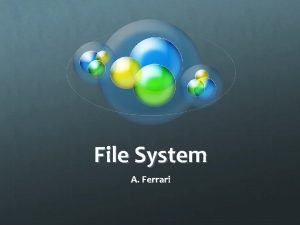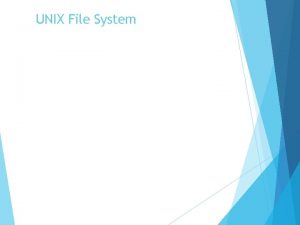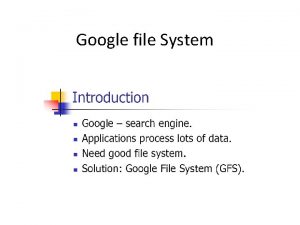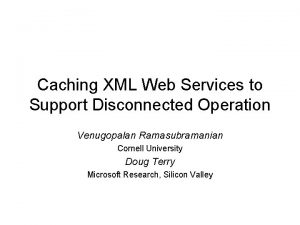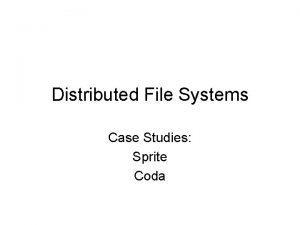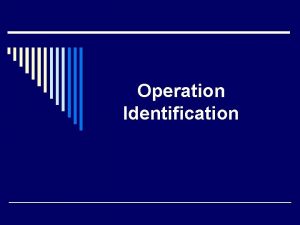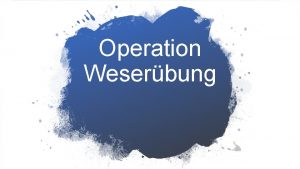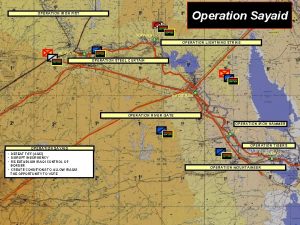DISCONNECTED OPERATION IN THE CODA FILE SYSTEM J







































- Slides: 39

DISCONNECTED OPERATION IN THE CODA FILE SYSTEM J. J. Kistler M. Sataynarayanan Carnegie-Mellon University

Paper Highlights • An overview of Coda • How Coda deals with disconnected operation – File hoarding • The paper mentions but does not discuss – Callbacks (covered in my presentation) – Weakly connected operation

CODA • Successor of the very successful Andrew File System (AFS) – First DFS aimed at a campus-sized user community • Key ideas include – open-to-close consistency – callbacks

General Organization (I) • Coda is tailored to access patterns typical of academic and research environments – Little sharing • Not intended for applications exhibiting highly concurrent file granularity data This lack of sharing is typical of UNIX file access system access patterns

General Organization (II) • Clients view Coda as a single locationtransparent shared Unix file system – Complements local file system • Coda namespace is mapped to individual file servers at the granularity of subtrees called volumes • Each client has a cache manager (VICE)

General Organization (III) • High availability is achieved through – Server replication: • Set of replicas of a volume is VSG (Volume Storage Group) • At any time, client can access AVSG (Available Volume Storage Group) – Disconnected Operation: • When AVSG is empty

Design Rationale • CODA major objectives were – Using off-the-shelf hardware – Preserving transparency • Other considerations included – Need for scalability – Advent of portable workstations – Hardware model being considered – Balance between availability and consistency

Scalability • AFS was scalable because – Clients cache entire files on their local disks – Cache coherence is maintained by the use of callbacks, which reduce server involvement art open time • Clients do most of the work • Coda adds replication

Portable Workstations • Laptops of the late 80’s had very small disk drives – Users were manually caching the files they planned to use while being disconnected • Coda has a single mechanism to handle – Voluntary disconnections – Involuntary disconnections

Hardware Model • CODA and AFS assume that client workstations are personal computers controlled by their user/owner – Fully autonomous – Cannot be trusted • CODA allows owners of laptops to operate them in disconnected mode – Opposite of ubiquitous connectivity

Other Models • Plan 9 and Amoeba – Computing is done by pool of servers – Workstations are just display units • NFS and XFS – Clients are trusted and always connected • Farsite – Untrusted clients double as servers

Accessibility • Must handle two types of failures – Server failures: • Data servers are replicated – Communication failures and voluntary disconnections • Coda uses optimistic replication and file hoarding

What about Consistency? • Pessimistic replication control protocols guarantee the consistency of replicated in the presence of any non. Byzantine failures – Typically require a quorum of replicas to allow access to the replicated data – Would not support disconnected mode

Example • Majority consensus voting: – Every update must involve a majority of replicas – Every majority contains at least one replica that was involved in the previous update 2 3 3

Pessimistic Replica Control • Would require client to acquire exclusive (RW) or shared (R) control of cached objects before accessing them in disconnected mode: – Acceptable solution for voluntary disconnections – Does not work for involuntary disconnections • What if the laptop remains disconnected

Leases • We could grant exclusive/shared control of the cached objects for a limited amount of time • Works very well in connected mode – Reduces server workload – Server can keep leases in volatile storage as long as their duration is shorter than boot time • Would only work for very short

Optimistic Replica Control (I) • Optimistic replica control allows access in every disconnected mode – Tolerates temporary inconsistencies – Promises to detect them later – Provides much higher data availability

Optimistic Replica Control (II) • Defines an accessible universe: set of replicas that the user can access – Accessible universe varies over time • At any time, user – Will read from the latest replica(s) in his accessible universe – Will update all replicas in his accessible universe –

IMPLEMENTATION • • Client structure Venus states Hoarding Prioritized cache management Hoard walk Persistence Reintegration

Client Structure Applicatio n Venus (connects with Coda servers) System call interface Vnode interface Coda Mini. Cache (handles local accesses)

Venus States (I) 1. Hoarding: Normal operation mode 2. Emulating: Disconnected operation mode 3. Reintegrating: Propagates changes and detects inconsistencies

Venus States (II) Hoarding Emulating Recovering

Prioritized Cache Management • Coda maintains a per-client hoard database (HDB) specifying files to be cached on client workstation – Client can modify HDB and even set up hoard profiles – Hoard entry may include a hoard priority • Actual priority is function of hoard priority and recent usage

Hoard Walking • Must ensure that no uncached object has a higher priority than a cached object • Since priorities are function of recent usage, they vary over time • Venus reevaluates priorities every ten minutes (hoard walk) – Hoard walk can also be requested by user, say, before a voluntary

Emulation • In emulation mode: – Attempts to access files that are not in the client caches appear as failures to application – All changes are written in a persistent log, the client modification log (CML) – Venus removes from log all obsolete entries like those

Persistence • Venus keeps its cache and related data structures in non-volatile storage • All Venus metadata are updated through atomic transactions – Using a lightweight recoverable virtual memory (RVM) developed for Coda – Simplifies Venus design

Reintegration • When workstation gets reconnected, Coda initiates a reintegration process – Performed one volume at a time – Venus ships replay log to all volumes – Each volume performs a log replay algorithm • Found later that it required a fast link between workstation and servers

STATUS AND EVALUATION • Reintegration can be time-consuming – requires very large data transfers • One hundred MB is enough for the cache size • Conflicts are infrequent – At most 0. 75% to have same file updated by two different users less than one day apart

Future Work • Coda added later a weak connectivity mode for portable computers linked to the CODA servers through slow links (like modems) – Allows for slow reintegration

SESSION SEMANTICS AND CALLBACKS • The paper does not cover the issue of session semantics and the role of callbacks – Essential part sof AFS design – Adopted by Coda

UNIX sharing semantics • Centralized UNIX file systems provide one-copy semantics – Every modification to every byte of a file is immediately and permanently visible to all processes accessing the file • AFS uses a open-to-close semantics • Coda uses an even laxer model

Open-to-Close Semantics (I) • First version of AFS – Revalidated cached file on each open – Propagated modified files when they were closed • If two users on two different workstations modify the same file at the same time, the users closing the file last will overwrite the changes made by the

Open-to-Close Semantics (II) • Example: F’ First client F’ F F” F” overwrites F’ F” Second Client Time

Open to Close Semantics (III) • Whenever a client opens a file, it always gets the latest version of the file known to the server • Clients do not send any updates to the server until they close the file • As a result – Server is not updated until file is closed

Callbacks (I) • AFS-1 required each client to call the server every time it was opening an AFS file – Most of these calls were unnecessary as user files are rarely shared • AFS-2 introduces the callback mechanism – Do not call the server, it will call you!

Callbacks (II) • When a client opens an AFS file for the first time, server promises to notify it whenever it receives a new version of the file from any other client – Promise is called a callback • Relieves the server from having to answer a call from the client every time the file is opened – Significant reduction of server

Callbacks (III) • Callbacks can be lost! – Client will call the server every tau minutes to check whether it received all callbacks it should have received – Cached copy is only guaranteed to reflect the state of the server copy up to tau minutes before the time the client opened the file for the last time

Coda semantics • Client keeps track of subset s of servers it was able to connect the last time it tried • Updates s at least every tau seconds • At open time, client checks it has the most recent copy of file among all servers in s – Guarantee weakened by use of callbacks

CONCLUSION • Coda – Puts scalability and availability before data consistency • Unlike NFS – Assumes that inconsistent updates are very infrequent – Introduced disconnected operation mode and file hoarding
 What is coda file system
What is coda file system Coda file system
Coda file system Afs vs nfs
Afs vs nfs Nfs architecture
Nfs architecture Coda file system architecture
Coda file system architecture Coda file
Coda file File-file yang dibuat oleh user pada jenis file di linux
File-file yang dibuat oleh user pada jenis file di linux 7ds network disconnected
7ds network disconnected Carbon family
Carbon family Disconnected epidural catheter guideline
Disconnected epidural catheter guideline Gvev
Gvev Simple disconnected graph with 3 vertices
Simple disconnected graph with 3 vertices Icesdptool
Icesdptool Is the dog barked a complete sentence
Is the dog barked a complete sentence File service architecture
File service architecture Remote file access in distributed file system
Remote file access in distributed file system In a file-oriented information system, a transaction file
In a file-oriented information system, a transaction file Syllable structure examples
Syllable structure examples Coronal consonants
Coronal consonants Formula imprenditoriale
Formula imprenditoriale Canto xvii inferno
Canto xvii inferno Go wish card game
Go wish card game Onset coda and nucleus
Onset coda and nucleus What is the main purpose of narrative writing
What is the main purpose of narrative writing Coda poliadenilata
Coda poliadenilata Metodo punta coda
Metodo punta coda Coda adatfolyam
Coda adatfolyam Trigonometria formule
Trigonometria formule Onset and coda examples
Onset and coda examples Rpcs34
Rpcs34 Coda sign in music
Coda sign in music Latin music terms
Latin music terms In the hall of the mountain king lesson plan
In the hall of the mountain king lesson plan Onset nucleus coda examples
Onset nucleus coda examples Neopterigi
Neopterigi Lgbt coda meetings
Lgbt coda meetings Coda residences
Coda residences Difference between logical file and physical file
Difference between logical file and physical file Fungsi sistem file
Fungsi sistem file An html file is a text file containing small markup tags.
An html file is a text file containing small markup tags.
